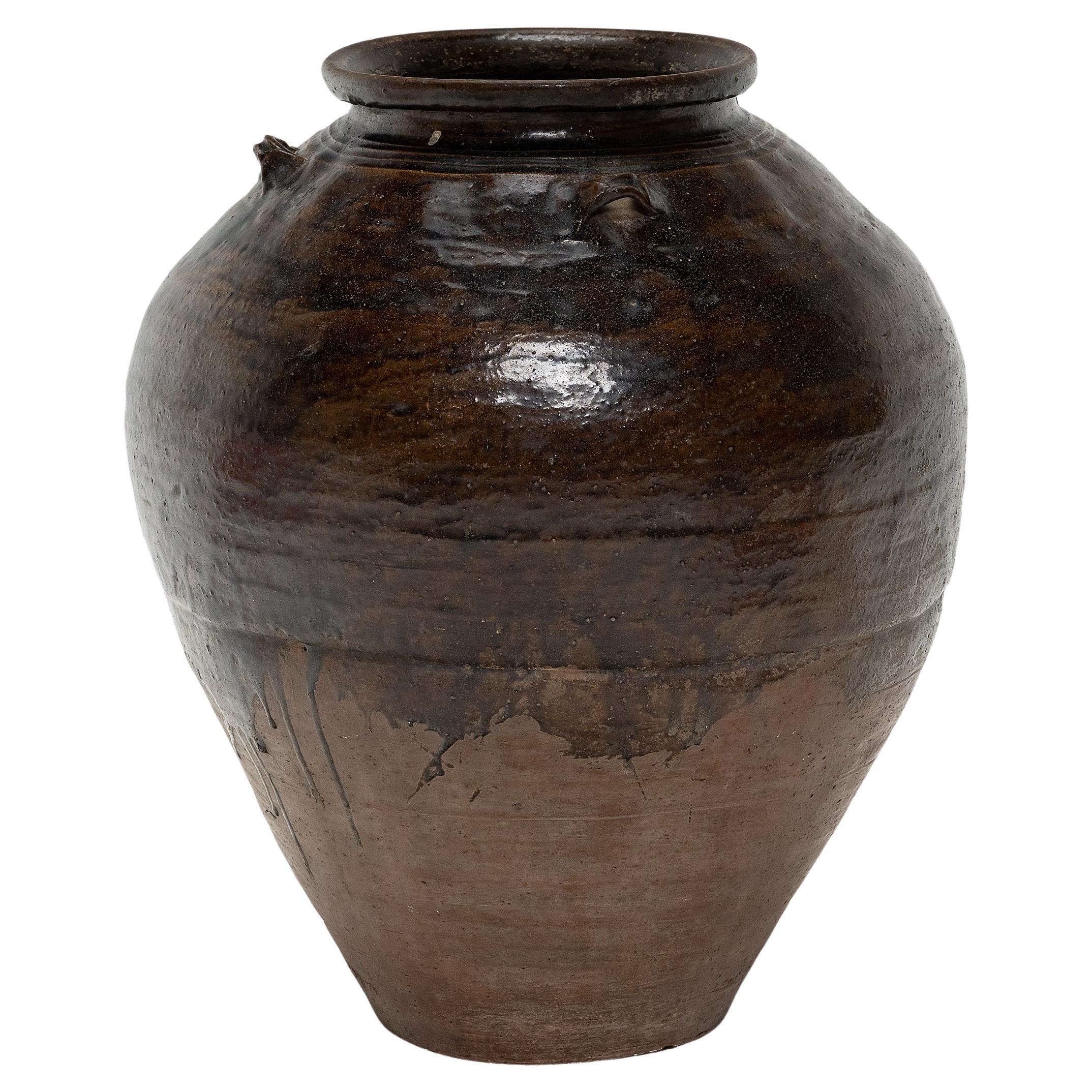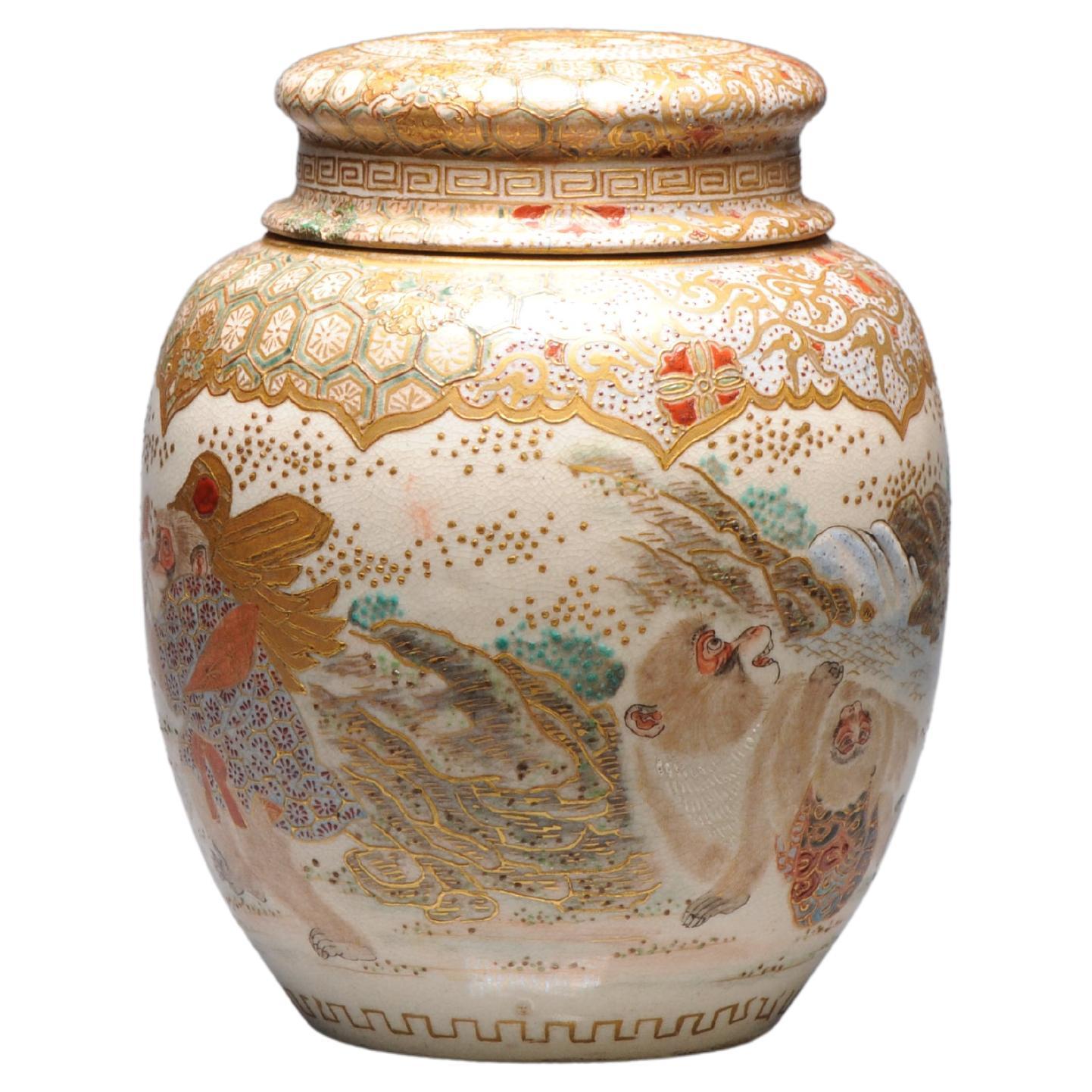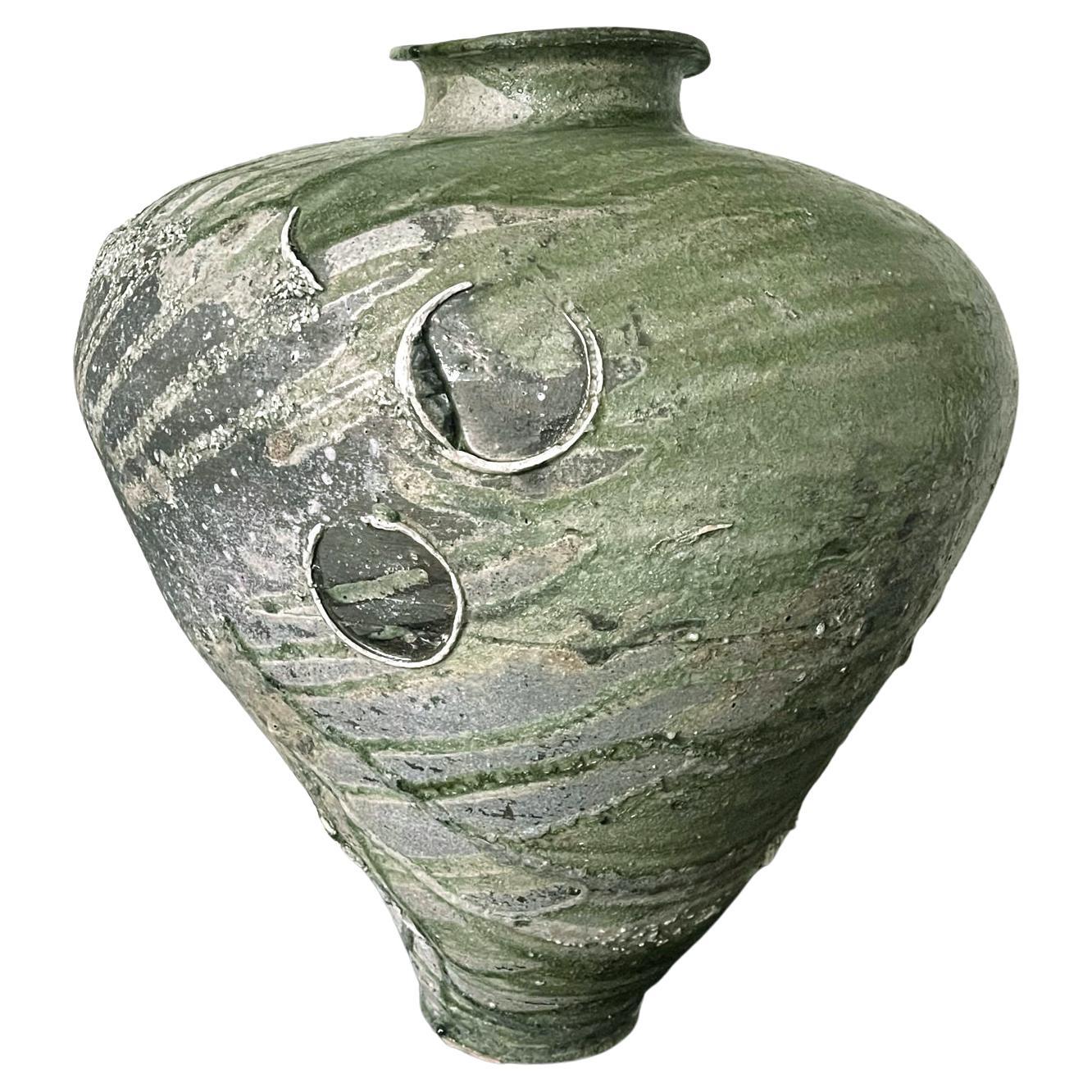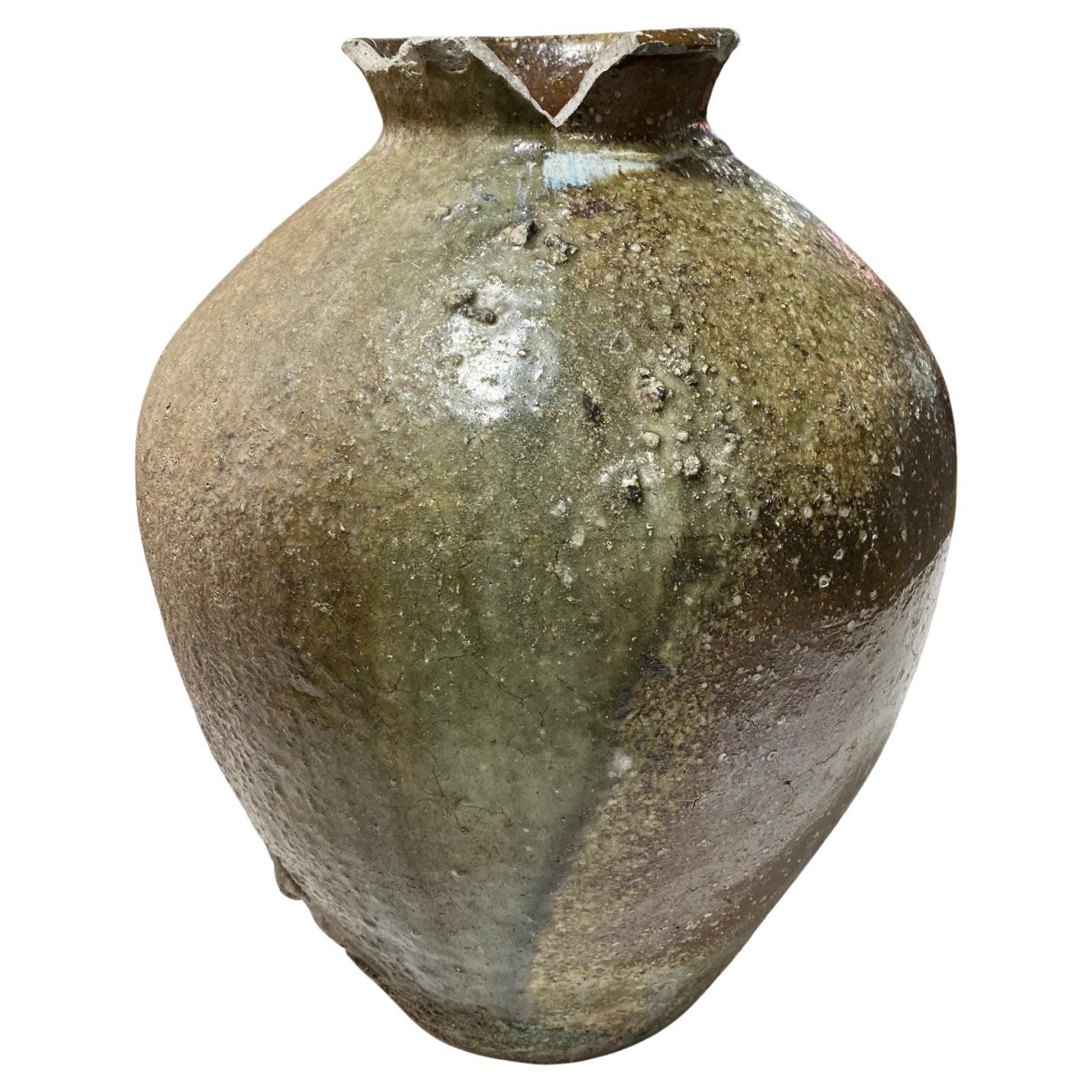Items Similar to Antique Japanese Tsubo Jar with High Relief Crab Design
Want more images or videos?
Request additional images or videos from the seller
1 of 16
Antique Japanese Tsubo Jar with High Relief Crab Design
About the Item
A Japanese stoneware tsubo (storage jar) circa 19th century (Meiji period), likely made in one of the Shigaraki or Echizen kilns. The jar has a thick robust body, and a short-neck rimmed mouth with deep groove. It was hand-coil built from a coarse clay, fired to an iron-rich deep earthy color. The surface is partially covered with a thick ash glaze that is splashed and pooled on one side of the upper part of the body and drips down in streaks/ The lower body and the base shows unglazed reddish clay. A highly unusual feature of this jar is that on its shoulder, quite unexpectedly, there is a high-relief sculpture of a sand crab, beautifully rendered in a realistic fashion. With the meticulous molding, sculpturing and glazing, the little creature appears visually embedded in its surrounding that was made to resemble sandy dirt as if it was just crawling out of its hidden place. The decoration was creative and genuinely smart, giving the sense of an accidental encounter when one views the jar.
The high-relief decoration technique itself is not unusual in Japanese ceramic-making. For instance, applied high relief ornaments is the main feature found on the heavily glazed Sumida ware. However, it is rare to see such method applied in unglazed stoneware such as Shigaraki or Echizen. The realistic rendition of the sand crab indicates that the work was likely made in the second half of the 19th century during Meiji instead of Edo period. Artist Makuzu Kozan (1842-1916), for instance, in his early career, developed a stunning output of high-relief sculptural work (1876-1881) known as Takauki ware. Although this tsubo was unlikely from his studio, it shares a similar spirit in its artistic method and aspiration.
Tsubos were used as storage jar for tea leaves or various types of liquor. Although unitarian by nature, the tea masters in Edo period highly appreciated their earthy wabi-sabi spirit thus elevated them to cherished collectibles.
- Dimensions:Height: 14 in (35.56 cm)Diameter: 10.5 in (26.67 cm)
- Style:Meiji (Of the Period)
- Materials and Techniques:Ceramic,Glazed
- Place of Origin:
- Period:
- Date of Manufacture:19th Century
- Condition:Wear consistent with age and use. Fine antique condition.8000Natural surface with irregular ash deposits and irregularity from the firing process, as made.
- Seller Location:Atlanta, GA
- Reference Number:1stDibs: LU945037139802
About the Seller
5.0
Platinum Seller
These expertly vetted sellers are 1stDibs' most experienced sellers and are rated highest by our customers.
Established in 2006
1stDibs seller since 2010
479 sales on 1stDibs
Typical response time: <1 hour
- ShippingRetrieving quote...Ships From: Atlanta, GA
- Return PolicyA return for this item may be initiated within 2 days of delivery.
More From This SellerView All
- Large Japanese Antique Shigaraki Tsubo JarLocated in Atlanta, GAAn antique Japanese stoneware storage jar, known as tsubo from Shigaraki kiln, circa 17th-18th century (early Edo possibly Momoyama period)....Category
Antique 17th Century Japanese Japonisme Ceramics
MaterialsCeramic
- Massive Ceramic Jar Tsubo by Japanese Potter Tsujimura YuiBy Tsujimura YuiLocated in Atlanta, GAA massive and magnificent ceramic Tsubo jar by Japanese potter Tsujimura Yui (1975-). Inspired by the techniques and aesthetics of the early medieval Sue ware, the artist hand builds an impressive voluminous oviform, irregular by intention, from a combination clay from both Shigaraki and Iga, coarse by nature and rich in feldspar. Fired on their sides horizontally, the surface of the thick wall tsubo is covered with streaks and drips of natural ash glazes in shades of green and blue, forming an abstract and mesmerizing pattern that resembles geothermal earth activity. Additional ashes are blown during the firing to accentuate the textures. Most recognizably, there are many circular marks scattered on the surface of his archaic looking vessels. That is resulted from using stacked tea bowls to prevent the conjoining of the vessels. After the firing, the stacked vessels are chipped away, leaving behind those circular impression, as well as deep pools of glaze which gather where they were placed. Born in 1975, Tsujimura Yui is the first son of the contemporary ceramic artist Tsujimura Shiro...Category
Early 2000s Japanese Modern Ceramics
MaterialsCeramic
- Large Contemporary Ceramic Tsubo Jar by Kai TsujimuraLocated in Atlanta, GAA massive stoneware tsubo floor jar created by Japanese contemporary ceramic artist Kai Tsujimura (1976-). The heavy jar with its impressive volume was made in the tradition of Iga ware with local coarse sandy clay that turned reddish after the firing. It took its shape from heavy medieval storage jars with a wide-open mouth. For a nearly identical form, see an Echizen jar from Heian period (794–1185) in the collection of MET (Accession Number: 1977.261). The surface showcases scattered white crystalized feldspars and a green vitrified ash glaze cascade down the body (known as biidoro in Japanese - after the Portuguese word for glass vidoro). These is a globular shape impressed on the jar. It is a signature practice of the Tsujimura potter family by stacking bowls between the pieces in the kiln during the firing, resulting in an accidental but iconic aethetic (Kai and Yui Tsujimura...Category
2010s Japanese Organic Modern Ceramics
MaterialsStoneware
- Japanese Echizen Ceramic Tsubo Fujita Jurouemon VIIILocated in Atlanta, GAA Japanese storage jar (tsubo) made in the ancient Echizen ware tradition by Fujita Jurouemon VIII. Echizen is one of the six ancient kilns in Japan, directly influenced by the Sue ware...Category
20th Century Japanese Modern Ceramics
MaterialsCeramic
- Fine Japanese Satsuma Ceramic Jar with Gilt Decoration by KinkozanBy KinkozanLocated in Atlanta, GAA large Japanese ceramic vase from end of Meiji period circa 1880s- 1910s by Kinkozan (1645-1927). One of the largest studio manufacturers of the export ceramics at the time based in Kyoto. In the typical style of satsuma made at the turn of 20th century, the vase is of a moon jar shape and finely decorated with kinran-de (gold paint) on a cream white background with even fine crackles. What sets this particular vase apart from many lower quality and mass-produced pieces is the meticulously renditioned surface decoration. Lavishly gilded with a continuous design, the carefully composed imagery depicts an elaborately decorated float cart in a festival parade. A group of people are seated within the float with a woman and a child standing in the front. Surrounding the float are streams of marchers dressed...Category
Early 20th Century Japanese Meiji Ceramics
MaterialsCeramic
- Antique Korean Porcelain Jar with Pheonix Design Joseon DynastyLocated in Atlanta, GAA korean white porcelain jar with underglaze blue paint circa late 19th century toward the end of Joseon Dynasty. Porcelain jars of this elongated form with swell shoulder, wide mout...Category
Antique Late 19th Century Other Ceramics
MaterialsPorcelain
You May Also Like
- Japanese Glazed Tsubo Wine Jar, c. 1875Located in Chicago, ILThis large, glazed stoneware vessel is a Meiji-era Japanese storage jar (tsubo) used for storing rice wine, water or even tea leaves and spices. Sometimes referred to as a Martaban j...Category
Antique Late 19th Century Japanese Meiji Ceramics
MaterialsStoneware
- Antique 19 C Japanese Satsuma Monkey Jar with Landscape, JapanLocated in Amsterdam, Noord HollandDescription Japanese Satsuma vase, Meiji period Of ovoid form with slightly domed cover, decorated with monkeys in robes frolicking in a landscape beside a river. Condition O...Category
Antique 19th Century Japanese Meiji Ceramics
MaterialsPorcelain
- Antique 19C Japanese Satsuma Flowers Foliage Jar with Landscape JapanLocated in Amsterdam, Noord HollandDescription A Japanese Satsuma vase, Meiji period Of ovoid shape and decorated with flowers and foliage between cell borders, later white metal collar and cover. Condition ...Category
Antique 19th Century Japanese Meiji Ceramics
MaterialsPorcelain
- Japanese Antique Large Edo Wabi-Sabi Shigaraki Art Pottery Jar Tsubo Pot VaseLocated in Studio City, CAAn absolutely stunning, beautifully shaped sumptuously glazed Shigaraki ware Japanese pottery vase/jar/pot - produced sometime during the Edo Period (1603-1867). Shigaraki ware is a ...Category
Antique Early 19th Century Japanese Edo Ceramics
MaterialsStoneware
- Japanese Antique Edo Wabi-Sabi Shigaraki Tamba Tanba Art Pottery Jar Tsubo VaseLocated in Studio City, CAA beautiful Tamba (Tanba) ware (or Sigaraki ware) Japanese pottery vase/jar/pot - produced sometime during the Edo Period (1603-1867). Tamba-yaki ware is a type of Japanese pottery a...Category
Antique 18th Century Japanese Edo Ceramics
MaterialsPottery, Stoneware
- Japanese Antique Muromachi Edo Wabi-Sabi Tokoname Art Pottery Jar Tsubo Pot VaseLocated in Studio City, CAAn absolutely stunning Tokoname ware stoneware vase/jar/vessel - produced sometime during the late Muromachi period (1336-1573 to early Edo Period (1603-1867). Tokoname-yaki ware is ...Category
Antique 16th Century Japanese Edo Ceramics
MaterialsPottery, Stoneware
Recently Viewed
View AllMore Ways To Browse
Japanese Tea Drip
Japanese Meiji Period Imari Porcelain Charger
Antique Korean Tea Bowl
Kwan Yin Porcelain Statue
Beautiful Beautiful Pottery Asian
Japanese Koinobori Windsock
Ming Dynasty Procession
Voc Charger
Yixing Zisha Teapot
Antique Japanese Bonsai Pot
Aubergine Clouds Japanese
Hadley Pottery
Japanese White Stork
Ming Dynasty Plates Chenghua Marked
Modern Japanese Studio Pottery Oribe Vase
Monkey Satsuma
Porcelain Qing Kangxi Dragon Bowl
Reverse Incense Burner





